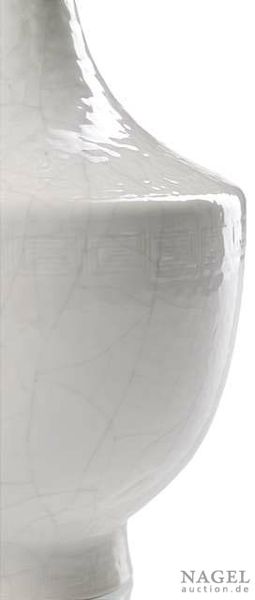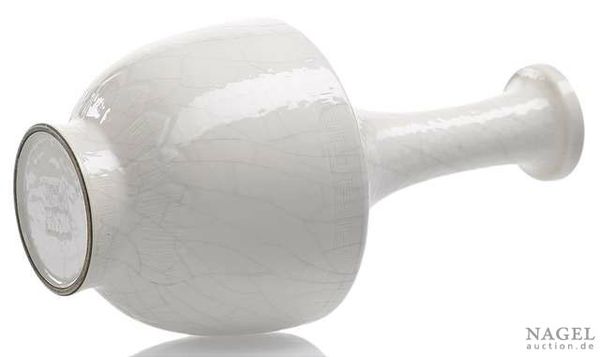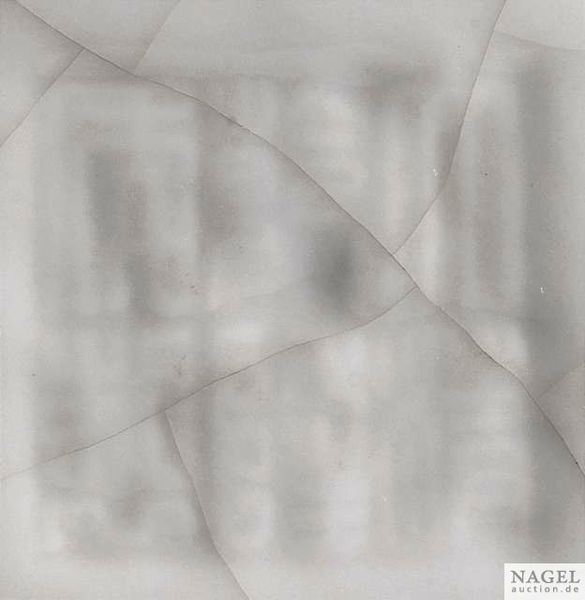A fine and rare creamy-white glazed soft-paste vase, China, impressed Qianlong six-character seal mark and of the period
A fine and rare creamy-white glazed soft-paste vase, China, impressed Qianlong six-character seal mark and of the period. Photo Nagel Auktionen
The thinly potted curving sides rise from a slightly splayed foot to an angled shoulde and a tall neck with a galiered rim, the foot and the lower part of the body impressed and incised with bands of key-fret and upright leaves, with scroll motifs above the sharp shoulder and around the neck, entirely covered in a transparent glaze suffused with crackles - Good condition. H. 16,5 cm. Estimate 30 000/50 000 €
Provenance: Former old European private collection, sold at Christie's London, 11.1.2011, Lot 1157
A similar example with a Yongzheng mark is in the Baur Collection, Catalogue, A422 also illustrated in Sekai Toji Zenshu, Shosakukan series, no. 89.
The Metropolitan Museum contains an example pottet very much in archaistic taste as a hu vase, of the Qianlong period, illustrated by Valenstein, Handbook, no. 163.
A fine vase relief-moulded with lotus, which appears to be soft-paste, was originally in the J.P. Morgan an F.M Mayer Collections, New York, exhibited at the Los Angeles County Museum, Chinese Ceramics, 1952, Catalogue, no. 341.
See also a related globular vase with trumpet neck, relief decorated with lotus, peony and honeysuckle, in the Victoria and Albert Museum, illustrated by Kerr, Ceramics, pl. 29. The author discusses the development of a new technique for making white porcelain in the 18th Century.
Although a vase of this type is commonly known as "soft paste", or more rarely "steatitic porcelain", the names are misleading. It involves the addition of a powdered white clay to the porcelain body, which in Chinese is called hua shi (slippery stone). Although referred to as steatite (decayed granite) by Westerners, Jingdezhen samples which have been analysed suggest that this is in fact merely another chemical form of kaolin. Added to a standard body, the potter could create a lightweight, somewhat creamy body, with a glaze which had a tendency to crackle on cooling ; it was, surprisingly, actually more expensive to produce than a standard kaolin body, as Pere d'Entrecolles observed in his second letter of 1722. For a full discussion, see Kerr, Ceramics, p. 53-54.
Nagel Auktionen. 2013/05/08. http://www.auction.de/

/https%3A%2F%2Fprofilepics.canalblog.com%2Fprofilepics%2F1%2F0%2F100183.jpg)
/https%3A%2F%2Fstorage.canalblog.com%2F03%2F02%2F119589%2F96711876_o.jpg)
/https%3A%2F%2Fstorage.canalblog.com%2F11%2F31%2F119589%2F94773502_o.jpg)
/https%3A%2F%2Fstorage.canalblog.com%2F20%2F83%2F119589%2F94772815_o.jpg)
/https%3A%2F%2Fstorage.canalblog.com%2F26%2F72%2F119589%2F75604929_o.jpg)
/https%3A%2F%2Fstorage.canalblog.com%2F59%2F60%2F119589%2F26458628_o.jpg)






/http%3A%2F%2Fstorage.canalblog.com%2F77%2F72%2F119589%2F122259057.jpg)
/http%3A%2F%2Fstorage.canalblog.com%2F65%2F19%2F119589%2F95698350_o.jpg)
/http%3A%2F%2Fstorage.canalblog.com%2F10%2F50%2F119589%2F74037399_o.jpg)
/image%2F1371349%2F20240426%2Fob_9bd94f_440340918-1658263111610368-58180761217.jpg)